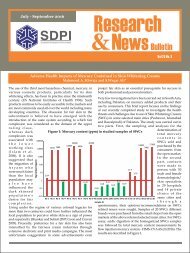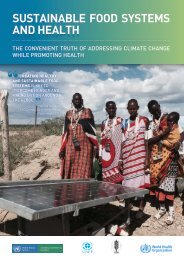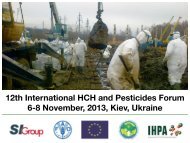Women and Chemicals
WomenAndChemicals_PublicationIWD2016
WomenAndChemicals_PublicationIWD2016
Create successful ePaper yourself
Turn your PDF publications into a flip-book with our unique Google optimized e-Paper software.
<strong>Women</strong>’s health<br />
under threat<br />
Typical diseases for women can be linked to chemical exposure. Many studies show<br />
associations between single substances <strong>and</strong> the development of breast cancer, infertility,<br />
obesity <strong>and</strong> many more diseases. Two diseases shall serve as examples to illustrate<br />
the kind of role chemicals can play in their outbreak. Breast cancer is a typical women’s<br />
disease. Infertility of women involves different biological factors than male infertility.<br />
3<br />
Although many studies are available, much more research is needed.<br />
Too many chemicals are not yet tested for their impact on women’s health.<br />
Additionally, very little comprehensive overview literature is available specifically<br />
on women’s health <strong>and</strong> chemicals.<br />
Breast cancer<br />
The first disease one would relate to the issue of chemicals <strong>and</strong><br />
women is probably breast cancer. The incidence rates of breast<br />
cancer have increased dramatically in recent years. These trends<br />
cannot be fully explained by the improvement of diagnosis,<br />
changes in established risk factors (age at menarche or menopause,<br />
genetic susceptibility, age of having babies) or life style<br />
causes. Epidemiological studies show evidence that chemicals<br />
like PCDD/F, PCBs, organic solvents, DDT/DDE, BPA, PAHs, phenols,<br />
alkylphenols, phthalates, parabens, styrene, metals, phytoestrogens,<br />
chemicals in first or second-h<strong>and</strong> smoke, <strong>and</strong> heavy<br />
metals like cadmium are linked to breast cancer. 1<br />
Most human studies have focused on adult exposure. However,<br />
some retrospective studies provide hints that early exposure<br />
to hormone disruptors plays a role in adult disease. For example,<br />
although some earlier studies showed no link between<br />
DDT <strong>and</strong> breast cancer, narrowing the suspected exposure to<br />
girls younger than 14 revealed a fivefold increase in breast cancer<br />
risk after age 50. 2<br />
A broad overview on the incidence of breast cancer is also<br />
given by Meriel Watts researching the link between pesticides<br />
<strong>and</strong> breast cancer. 3 The reported incidence rate for breast cancer<br />
varies enormously between countries. Reported rates are highest<br />
in the USA, Europe, New Zeal<strong>and</strong>, Canada <strong>and</strong> Australia, <strong>and</strong><br />
lowest in Asia <strong>and</strong> Africa. Mortality of breast cancer shadows the<br />
incidence. 4 This regional variation in breast cancer incidence<br />
could be a result only of the substantial underreporting in many<br />
developing countries. Many poor rural women simply cannot afford<br />
to go to the doctor or have access to basic health care <strong>and</strong><br />
hence their breast cancer may never be recorded. Additionally,<br />
not all countries have adequate breast cancer registries even for<br />
those cases that are seen by a doctor. Hence the breast cancer<br />
rate even in these countries may in fact be higher than the currently<br />
available statistics reveal. 5<br />
Conventionally accepted risk factors only account for 30<br />
to 50 per cent of all breast cancers. 6 This leaves 50 to 70 per<br />
cent of cases with no known cause. This is where the environment<br />
<strong>and</strong> the exposure to toxic chemicals get in the focus as<br />
causes. Andreas Kortenkamp, for example, sees evidence<br />
emerging that environmental influences, including chemical<br />
exposure, play a vital role. 7 Studies among Sc<strong>and</strong>inavian twins<br />
on breast cancer suggest this. They have found that heritability<br />
accounted for 27 per cent, environmental factors that were<br />
shared by both twins explained 6 per cent, <strong>and</strong> environmental<br />
factors not common to the pair contributed 67 per cent. 9 As it<br />
seems that the most important contributors to the development<br />
of breast cancer are non-genetic or environmental,<br />
much more attention has to be paid to those factors. As<br />
chemical exposure is one prominent non-genetic as well as<br />
17







